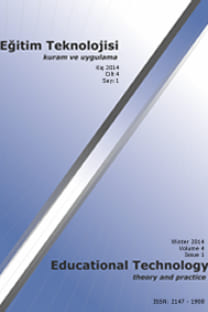ÖĞRENCİLERİN STEM KARİYER TERCİHLERİNİN VERİ MADENCİLİĞİ YAKLAŞIMI İLE TAHMİN EDİLMESİ
PREDICTING STUDENTS’ STEM CAREER INTERESTS BY USING DATA MINING APPROACH
___
- Baker, R. S. J. d. (2007). Modeling and understanding students' off-task behavior in intelligent tutoring systems. Paper presented at the Proceedings of the SIGCHI Conference on Human Factors in Computing Systems, San Jose, California, USA.
- Chawla, N. V. (2005). Data Mining for Imbalanced Datasets: An Overview. In O. Maimon & L. Rokach (Eds.), Data Mining and Knowledge Discovery Handbook (pp. 853-867). Boston, MA: Springer US.
- Desmarais, M. C., & Baker, R. S. (2012). A review of recent advances in learner and skill modeling in intelligent learning environments. User Modeling and User-Adapted Interaction, 22(1-2), 9-38. doi: 10.1007/s11257-011-9106-8
- Feng, M., Heffernan, N., & Koedinger, K. (2009). Addressing the assessment challenge with an online system that tutors as it assesses. User Modeling and User-Adapted Interaction, 19(3), 243-266. doi: 10.1007/s11257-009-9063-7
- Heffernan, N. T., & Heffernan, C. L. (2014). The ASSISTments Ecosystem: Building a Platform that Brings Scientists and Teachers Together for Minimally Invasive Research on Human Learning and Teaching. International Journal of Artificial Intelligence in Education, 24(4), 470-497. doi: 10.1007/s40593-014-0024-x
- Koedinger, K., Baker, R., Cunningham, K., Skogsholm, A., Leber, B., & Stamper, J. (2010). A data repository for the EDM community: The PSLC DataShop. Handbook of educational data mining, 43. doi: citeulike-article-id:13242329
- Kowarik, A., & Templ, M. (2016). Imputation with the R Package VIM. 2016, 74(7), 16. doi: 10.18637/jss.v074.i07
- Kuhn, M. (2008). Building Predictive Models in R Using the caret Package. 2008, 28(5), 26. doi: 10.18637/jss.v028.i05
- Olmo, J. L., Romero, C., Gibaja, E., & Ventura, S. (2015). Improving Meta-learning for Algorithm Selection by Using Multi-label Classification: A Case of Study with Educational Data Sets. International Journal of Computational Intelligence Systems, 8(6), 1144-1164. doi: 10.1080/18756891.2015.1113748
- Pardos, Z. A., Baker, R. S. J. D., San Pedro, M., Gowda, S. M., & Gowda, S. M. (2014). Affective States and State Tests: Investigating How Affect and Engagement during the School Year Predict End-of-Year Learning Outcomes. 2014, 1(1), 22. doi: 10.18608/jla.2014.11.6
- Pedro, M. O., Baker, R., Bowers, A., & Heffernan, N. (2013). Predicting college enrollment from student interaction with an intelligent tutoring system in middle school. Paper presented at the Educational Data Mining 2013.
- Pedro, M. O., Ocumpaugh, J., Baker, R., & Heffernan, N. (2014). Predicting STEM and non-STEM college major enrollment from middle school interaction with mathematics educational software. Paper presented at the Educational Data Mining 2014.
- Peña-Ayala, A. (2014). Educational data mining: A survey and a data mining -based analysis of recent works. Expert Systems with Applications, 41(4, Part 1), 1432-1462. doi: doi.org/10.1016/j.eswa.2013.08.042
- R Core Team. (2017). R: A language and environment for statistical computing: R Foundation for Statistical Computing. Retrieved from https://www.R-project.org/
- Refaeilzadeh, P., Tang, L., & Liu, H. (2016). Cross-Validation. In L. Liu & M. T. Özsu (Eds.), Encyclopedia of Database Systems (pp. 1-7). New York, NY: Springer New York.
- San Pedro, M. O. C. Z., Baker, R. S. J. d., & Rodrigo, M. M. T. (2011). Detecting Carelessness through Contextual Estimation of Slip Probabilities among Students Using an Intelligent Tutor for Mathematics, Berlin, Heidelberg.
- San Pedro, M. O. Z., Baker, R. S. J. d., Gowda, S. M., & Heffernan, N. T. (2013). Towards an Understanding of Affect and Knowledge from Student Interaction with an Intelligent Tutoring System. In H. C. Lane, K. Yacef, J. Mostow & P. Pavlik (Eds.), Artificial Intelligence in Education: 16th International Conference, AIED 2013, Memphis, TN, USA, July 9-13, 2013. Proceedings (pp. 41-50). Berlin, Heidelberg: Springer Berlin Heidelberg.
- Stamper, J., Koedinger, K., Baker, R. S. J. d., Skogsholm, A., Leber, B., Rankin, J., & Demi, S. (2010). PSLC DataShop: A Data Analysis Service for the Learning Science Community, Berlin, Heidelberg.
- Yu, H.-F., Lo, H.-Y., Hsieh, H.-P., Lou, J.-K., McKenzie, T. G., Chou, J.-W., . . . Lin, C.-J. (2010). Feature Engineering and Classifier Ensemble for KDD Cup 2010.
- ISSN: 2147-1908
- Yayın Aralığı: Yılda 2 Sayı
- Başlangıç: 2011
- Yayıncı: Tolga Güyer
ÖĞRENCİLERİN STEM KARİYER TERCİHLERİNİN VERİ MADENCİLİĞİ YAKLAŞIMI İLE TAHMİN EDİLMESİ
Gökhan AKÇAPINAR, Erdal COŞGUN
Yıldız ÖZAYDIN AYDOĞDU, Şeyhmus AYDOĞDU, Mehmet Akif OCAK
3D TASARIM ÖĞRENME DENEYİMİNİN SÜREÇ DEĞERLENDİRMESİ VE EĞİTSEL ÇIKTILARININ KEŞFEDİLMESİ
Akça Okan YÜKSEL, Ekmel ÇETİN, Burcu BERİKAN
BİLİŞİM TEKNOLOJİLERİ ALANINDA MESLEK SEÇİMİNİ YORDAYAN DEĞİŞKENLER
HERKÜL’ÜN HİKÂYESİ: EĞİTSEL BİR OYUN GELİŞTİRME MODELİ ÖNERİSİ
Fatma BAYRAK, Pınar NUHOĞLU, Şeyma ÇAĞLAR ÖZHAN, Selay Arkün KOCADERE
VİDEO KAPILMA ÖLÇEĞİNİN UYARLAMA, GEÇERLİK VE GÜVENİRLİK ÇALIŞMASI
Deniz DERYAKULU, Raziye SANCAR, Ömer Faruk URSAVAŞ
ÇEVRİMİÇİ ÖDEV GÖNDERME VE DÖNÜT ALMA SÜRECİNDE ÖĞRENCİ KATILIM DAVRANIŞLARI
Özden ŞAHİN İZMİRLİ, Gökhan ÇALIŞKAN, Serkan İZMİRLİ
3B TASARIM ÖĞRENME DENEYİMİNİN SÜREÇ DEĞERLENDİRMESİ VE EĞİTSEL ÇIKTILARININ KEŞFEDİLMESİ
Akça Okan YÜKSEL, Burcu BERİKAN, Ekmel ÇETİN
Ayşe BAĞRIACIK YILMAZ, Serçin KARATAŞ
EĞİTİMDE SANAL GERÇEKLİK UYGULAMALARINDA ERİŞİLEBİLİRLİK VE UYUMLULUK
Mehmet BÜTÜN, Veli Özcan BUDAK, Murat SELÇUK, İlkim Ecem EMRE, İrfan ŞİMŞEK
